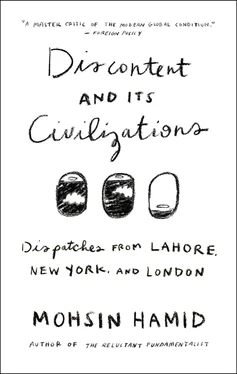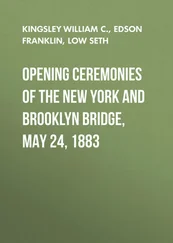In the meantime American, Pakistani, Afghan, and terrorist commanders will go on conducting their operations, the slaughter will continue, and human beings — all equal, all equal — will keep dying, their deaths mostly invisible to the outside world but at a rate evoking a line of aircraft stretching off into the distance, bearing down upon tower after tower after tower. Bin Laden is dead. But many Pakistanis sense the impending arrival of yet another murderous plane, headed their way.
(2011)
Why They Get Pakistan Wrong
NEARLY TEN YEARS after the terrorist attacks of September 11, 2001, and the commencement of the US-led war in Afghanistan, the alliance between the US and Pakistan is on shaky ground. The killing of Osama bin Laden by US special forces this May in Abbottabad, Pakistan, has incensed officials on both sides: on the American side because Bin Laden’s hiding place appears to suggest Pakistani perfidy; and on the Pakistani side because the US raid humiliatingly violated Pakistan’s sovereignty.
As Ted Poe, a Republican congressman on the House Committee on Foreign Affairs, puts it: “Unless the State Department can certify to Congress that Pakistan was not harboring America’s number-one enemy, Pakistan should not receive one more cent of American funding.” Dramatic words,* for Pakistan has been allocated quite a few cents of American funding. Yet this money has bought little love. According to the Pew Global Attitudes Project, only 12 percent of Pakistanis have a favorable opinion of the United States, and only 8 percent would like to see US troops “stay in Afghanistan until the situation has stabilized.” Why might this be the case?
The past decade has been devastating for Pakistan. The country’s annual death toll from terrorist attacks rose from 164 in 2003 to 3,318 in 2009, a level exceeding the number of Americans killed on September 11. Some 35,000 Pakistanis, including 3,500 members of security forces, have died in terror and counterterror violence. Millions more have been displaced by fighting. It is difficult to convey how profoundly the country has been wounded. In 1989, my Lahore American School classmates and I (including children from Pakistan, America, Canada, Sweden, Germany, and Korea) were able to go to the beautiful valley of Swat by bus for a weeklong field trip with no security arrangements whatsoever. In 2009, the battle to retake Swat from Taliban militants involved two full divisions of the Pakistani army and hundreds of casualties among Pakistani soldiers. (Similarly, until a few years ago, there had never been a suicide bombing in Lahore. Now one occurs every three or four months.) The Pakistani government puts direct and indirect economic losses from terrorism over the last ten years at $68 billion.
Of the $20.7 billion in US funding allocated to Pakistan from 2002 to 2010, $14.2 billion was for the Pakistani military. On paper, economic assistance came to $6.5 billion, less than a third of the total. In reality the civilian share was even smaller, probably less than a quarter, for the $6.5 billion figure reflects “commitments” (amounts budgeted by the US), not “disbursements” (amounts actually given to Pakistan). The United States Government Accountability Office reports that only 12 percent of the $1.5 billion in economic assistance to Pakistan authorized for 2010 was actually disbursed that year. Independent calculations by the Center for Global Development suggest that $2.2 billion of civilian aid budgeted for Pakistan is currently undisbursed, meaning that total economic assistance actually received from the US over the past nine years is in the vicinity of $4.3 billion, or $480 million per year. (By comparison, Pakistanis abroad remit $11 billion to their families in Pakistan annually, over twenty times the flow of US economic aid.)
Pakistan is a large country, with a population of 180 million and a GDP of $175 billion. Average annual US economic assistance comes to less than 0.3 percent of Pakistan’s current GDP, or $2.67 per Pakistani citizen. Here in Lahore, that’s the price of a six-inch personal-size pizza with no extra toppings from Pizza Hut.
The alliance between the US and Pakistan is thus predominantly between the US and the Pakistani military. To enter the US as a Pakistani civilian “ally” now (a Herculean task, given ever-tighter visa restrictions) is to be subjected to hours of inane secondary screening upon arrival. (“Have you ever had combat training, sir?”) For a decade, meanwhile, successive civilian Pakistani finance ministers have gone to Washington reciting a mantra of “trade not aid.” They have been rebuffed, despite a WikiLeaked 2010 cable from the US embassy in Islamabad strongly supporting a free trade agreement with Pakistan and citing research showing that such an arrangement would likely create 1.4 million new jobs in Pakistan, increase Pakistani GDP growth by 1.5 percent per year, double inflows of foreign direct investment to Pakistan, and (because Pakistani exports would come largely from textile industries that US-based manufacturers are already exiting) have “no discernible impact” on future US employment.
Perhaps the vast majority of Pakistanis with an unfavorable view of the United States simply believe their annual free pizza is not worth the price of a conflict that claims the lives of thousands of their fellow citizens each year.
—
PAKISTANI JOURNALIST Zahid Hussain, in The Scorpion’s Tail , his examination of the rise of militants in Pakistan, makes clear that both sides of the alliance between the US and the Pakistani military share blame for the violence currently afflicting Pakistan. A long series of mutual policy missteps led to the present bloodshed.
As Hussain reminds us, the US and the Pakistani military together backed the Afghanistan guerrilla campaign against the Soviet invasion in the 1980s, thereby bequeathing to the world unprecedented international networks of well-trained jihadist militants. For the US, as in its previous alliance with the Pakistani military in the 1950s and 1960s, the primary objective was to counter the Soviets. For the Pakistani military, as ever, the primary objective of the alliance was to lessen India’s superiority in conventional arms. The US gained a proxy fighting force in the form of the Afghan mujahideen (literally: “people who do jihad”). The Pakistani military gained access to advanced US-made weapons, the most important of which were forty F-16 fighter aircraft: too few, obviously, to resist any full-blown Soviet air assault, but enough to strengthen meaningfully the Pakistan air force against its Indian rival.
With the Soviet withdrawal, America turned abruptly away from the region and washed its hands of its militant co-creations; in the ensuing power vacuum Afghanistan descended into a bloody civil war among former mujahideen. The US also severed its alliance with the Pakistani military, cutting off supplies of spare parts for Pakistan’s American weapons and withholding delivery of further F-16s that Pakistan had paid for but not yet received.
The outraged Pakistani military was seriously weakened as a conventional fighting force vis-à-vis India. But it now, as Hussain shows, had enormous experience of projecting power through jihadist militants and two opportunities to continue doing so. One was in the Indian-controlled part of Kashmir (the divided Muslim-majority territory at the center of the Indian — Pakistani conflict, claimed in its entirety by both Hindu-majority India and Muslim-majority Pakistan), where an insurgency against Indian troops had broken out in 1989 following a disputed election.
The other was in Afghanistan, where the largely ethnic-Pashtun, Pakistan-backed Taliban were battling the largely non-Pashtun, India-backed Northern Alliance, consisting of Tajiks, Uzbeks, Hazaras, and others. During the 1990s, Hussain writes, “The jihadist movement in Pakistan was focused entirely on supporting the regional strategy of the Pakistani military establishment: to liberate Kashmir from India and install a Pashtun government in Afghanistan.”
Читать дальше












